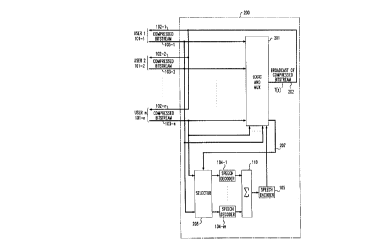Une partie des informations de ce site Web a été fournie par des sources externes. Le gouvernement du Canada n'assume aucune responsabilité concernant la précision, l'actualité ou la fiabilité des informations fournies par les sources externes. Les utilisateurs qui désirent employer cette information devraient consulter directement la source des informations. Le contenu fourni par les sources externes n'est pas assujetti aux exigences sur les langues officielles, la protection des renseignements personnels et l'accessibilité.
L'apparition de différences dans le texte et l'image des Revendications et de l'Abrégé dépend du moment auquel le document est publié. Les textes des Revendications et de l'Abrégé sont affichés :
| (12) Brevet: | (11) CA 2114868 |
|---|---|
| (54) Titre français: | DISPOSITIF DE PRISE EN CHARGE DE SIGNAUX DE CONFERENCE COMPRIMES |
| (54) Titre anglais: | CONFERENCING ARRANGEMENT FOR COMPRESSED INFORMATION SIGNALS |
| Statut: | Réputé périmé |
| (51) Classification internationale des brevets (CIB): |
|
|---|---|
| (72) Inventeurs : |
|
| (73) Titulaires : |
|
| (71) Demandeurs : | |
| (74) Agent: | KIRBY EADES GALE BAKER |
| (74) Co-agent: | |
| (45) Délivré: | 1997-12-23 |
| (22) Date de dépôt: | 1994-02-03 |
| (41) Mise à la disponibilité du public: | 1994-09-25 |
| Requête d'examen: | 1994-02-03 |
| Licence disponible: | S.O. |
| (25) Langue des documents déposés: | Anglais |
| Traité de coopération en matière de brevets (PCT): | Non |
|---|
| (30) Données de priorité de la demande: | ||||||
|---|---|---|---|---|---|---|
|
Technique de pont de conférence pour les signaux compressés d'information qui surveille l'énergie des signaux transmise par chaque participant. Si seulement un participant parle, le circuit de sommation du pont est contourné ainsi que l'appareil de codage/décodage des signaux vocaux et le signal du participant qui parle est diffusé à tous les participants. S'il y a plus d'un participant qui parle à un moment donné, alors seulement les signaux vocaux d'un des participants sont acheminés vers un décodeur correspondant de signaux vocaux où les signaux compressés du participant sont décompressés. Ces signaux compressés sont ensuite combinés par le circuit de sommation et la somme est compressée de nouveau et diffusée à tous les participants. Avantageusement, la technique décrite ci-dessus élimine la dégradation de signaux correspondant à la mise en tandem d'opérations de codage et de décodage de signaux et permet le partage d'un plus petit nombre de décodeurs entre un plus grand nombre de participants.
-8-
A conferencing bridging technique for compressed information signals
which monitors the signal energy transmitted by each conferee. When there is only
one conferee speaking, the summing circuit in the bridge unit is bypassed along with
the speech decoding/coding apparatus and the talking conferee's signal is broadcast
to all conferees. If there is more than one conferee speaking at any given time, then
only the speaking conferee's signals are routed to an associated speech decoder
wherein those conferees' compressed signals are decompressed. These
decompressed signals are then combined by the summing circuit and the sum is
recompressed and broadcast to all conferees. Advantageously, the above-describedtechnique eliminates the signal degradation associated with tandeming of signal
decoding and coding operations and permits the sharing of a smaller number of
signal decoders among a larger number of conferees.
Note : Les revendications sont présentées dans la langue officielle dans laquelle elles ont été soumises.
Note : Les descriptions sont présentées dans la langue officielle dans laquelle elles ont été soumises.

Pour une meilleure compréhension de l'état de la demande ou brevet qui figure sur cette page, la rubrique Mise en garde , et les descriptions de Brevet , États administratifs , Taxes périodiques et Historique des paiements devraient être consultées.
| Titre | Date |
|---|---|
| Date de délivrance prévu | 1997-12-23 |
| (22) Dépôt | 1994-02-03 |
| Requête d'examen | 1994-02-03 |
| (41) Mise à la disponibilité du public | 1994-09-25 |
| (45) Délivré | 1997-12-23 |
| Réputé périmé | 2009-02-03 |
Il n'y a pas d'historique d'abandonnement
Les titulaires actuels et antérieures au dossier sont affichés en ordre alphabétique.
| Titulaires actuels au dossier |
|---|
| AMERICAN TELEPHONE AND TELEGRAPH COMPANY |
| Titulaires antérieures au dossier |
|---|
| NAHUMI, DROR |